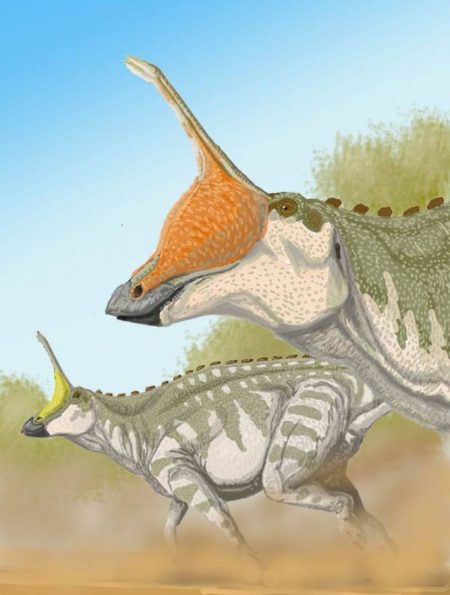Tsintaosaurus

Tsintaosaurus (meaning “Qingdao lizard”, after the old transliteration “Tsingtao”) is a genus of hadrosaurid dinosaur from China. It was about 10 metres (33 ft) long, 3.6 metres (12 ft) tall and weighed 3 tons. The type species is Tsintaosaurus spinorhinus, first described by Chinese paleontologist C. C. Young in 1958.
A hadrosaur, Tsintaosaurus had a characteristic ‘duck bill’ snout and a battery of powerful teeth which it used to chew vegetation. It usually walked on all fours, but could rear up on its hind legs to scout for predators and flee when it spotted one. Like other hadrosaurs, Tsintaosaurus probably lived in herds.

Crest
Tsintaosaurus was originally reconstructed with a unicorn-like crest on its skull. The crest, as preserved, consists of an about forty centimetres long process, protruding almost vertically from the top of the rear snout. The structure is hollow and seems to have a forked upper end. Comparable structures with related species are unknown: they possess more lobe-like crests. In 1990, David Weishampel and Jack Horner cast doubt on the presence of the crest, suggesting that it was actually a broken nasal bone from the top of the snout distorted upward by a crushing of the fossil. Their study further suggested that, without the distinctive crest to distinguish it, Tsintaosaurus was actually a synonym of the similar but crestless hadrosaur Tanius. However, in 1993 Eric Buffetaut e.a., after a renewed investigation of the bones themselves, concluded that the crest was neither distorted nor an artefact of restoration; besides, a second specimen with an upright crest part had since been discovered, indicating that the crest was indeed real and Tsintaosaurus is likely a distinct genus.

Tsintaosaurus may form a clade in Lambeosaurinae with the European genera Pararhabdodon and Koutalisaurus (probable synonym of Pararhabdodon).
The position of Tsintaosaurus in the evolutionary tree according to a 2013 study by Prieto-Márquez e.a. is indicated by this cladogram:

Source: www.Wikipedia, www.NatGeo.com








